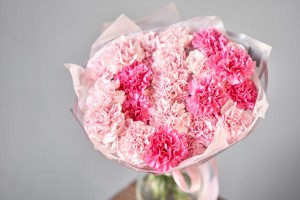 In the winter I tend to avoid doing necessary things, like cleaning out closets, in favor of wallowing in garden catalogs, shelter magazines, and my large collection of garden and horticultural books. I was indulging myself the other day, when I found out, courtesy of one of the better shelter magazines, that carnations are unfashionable.
In the winter I tend to avoid doing necessary things, like cleaning out closets, in favor of wallowing in garden catalogs, shelter magazines, and my large collection of garden and horticultural books. I was indulging myself the other day, when I found out, courtesy of one of the better shelter magazines, that carnations are unfashionable.
Clearly if a shelter magazine is “rediscovering” carnations, the flowers, which have been cultivated since ancient times, are about to become fashionable again. This has happened to the Dianthus species scores of times over the course of the millennia.
Fashionable or not, I love carnations. They are great garden plants, not to mention the best of cut flowers. A couple of bunches of cheap carnations from the supermarket look wonderful, smell delicious and will last you at least three weeks, as long as you change the water periodically. As minor aesthetic investments go, that is one of the best.
That wonderful look comes from the combination of “pinked” or ragged petal edges and opulent double or semi-double petal configurations. Lovely color is a given.
The dianthus family is home to carnations of all sizes, not to mention sweet Williams and the short-statured plants known in this country as “pinks”. In Europe, especially in Great Britain, the term “pinks” is used more generally to include just about all dianthus. Given the amount of interbreeding among species over the years, this may be the best informal way to categorize the whole group.
The magazine article dealt with ways of arranging the large-flowered carnations, which are ubiquitous anywhere that sells cut flowers. These are generally referred to as “florist’s carnations” and are grown for the cut flower trade under greenhouse or controlled field conditions. Cultivars that grow outdoors in home gardens are categorized as “border carnations”. The mind reels at the number of varieties of both types.
I am thinking about the large-flowered “border carnations”, which are the result of hybridization of several different species. Author and gardener Vita Sackville West wrote admiringly about the Chabaud carnations, developed by a French hybridizer in the eighteen seventies. Some are still in commerce today, but both old and new varieties are available now in colors ranging from purest white to near-black. Bi-colors are common. There are no true blue carnations, unless you put a cut stem in a container of water mixed with blue dye, but the color and pattern range is still impressive.
At the moment, the fanciful side of my gardening self is drawn to the old-fashioned—or at least old-fashioned in appearance–patterned varieties like ‘Chomley Farran’, wildly striped in purple and magenta; or ‘Grace Bay’, a frilly yellow variety with petals edged in red. The shorter Odessa ‘Pierrot’, features dark red petals edged in white.
The common trait among border carnations is stature. The slender flower stalks can run to 16 inches, accented by grassy foliage, which is often grey-green in color. Scent is also a constant and one of the great attractions of the dianthus family. The fragrance of carnations is often described as “spicy”, and to my nose, the predominant note is clove. Some carnations have a sweeter scent, with fainter spice notes.
Carnations are one of two fragrant flowers that have brought me to grief as a gardener. The other is sweet peas. The problem with carnations is that they do not seem to thrive in my soil, probably because of its acidic, heavy clay composition. Last summer my grief turned to joy when I found an irresistible double apricot carnation and raised it in a large terra cotta container. It bloomed on and off all summer, exuding its wonderful fragrance and restoring my faith in my horticultural skills.
Now, as I prepare for the coming growing season, I am hip-deep in catalogs and on the hunt for the most beautiful carnations. My basement and garage are full of containers and the garden centers are full of potting soil, so the possibilities are tantalizing. I think that I will pick a range of colors and sprinkle the pots through the sunny parts of my garden, especially in places where I am likely to go every day. The pots will have to be collected and overwintered in a sheltered spot every year, but it is a small price to pay for all that beauty.
In the meantime, I will salve my winter-weary soul with supermarket carnations.
For pure dianthus inspiration, I would suggest going to the website for Whetman Garden Plants, an English firm that specializes in the genus. Find them at https://whetmangardenplants.co.uk/. For actual plants, try Bluestone Perennials, 7211 Middle Ridge Rd. Madison, OH 44057; (800) 852-5243; www.bluestoneperennials.com. Print catalog available. Take a look at Bluestone’s ‘Pinball Wizard’, a modern variety with old fashioned looks. If you like carnations, it will make your spirits soar.
